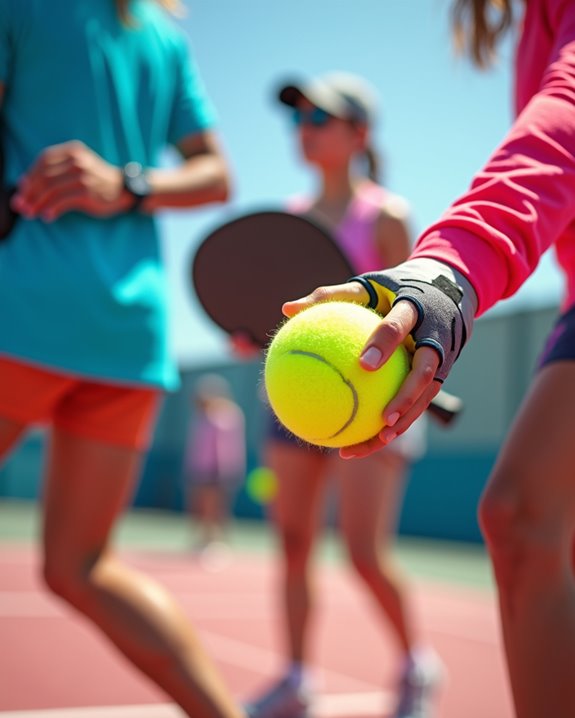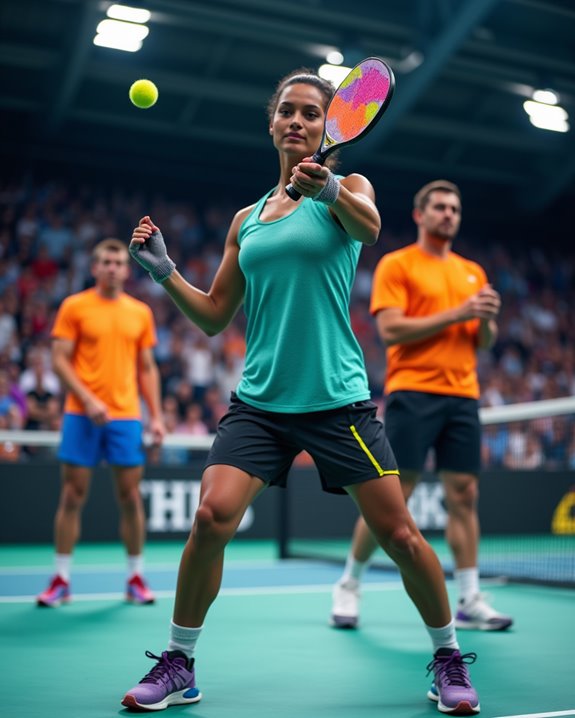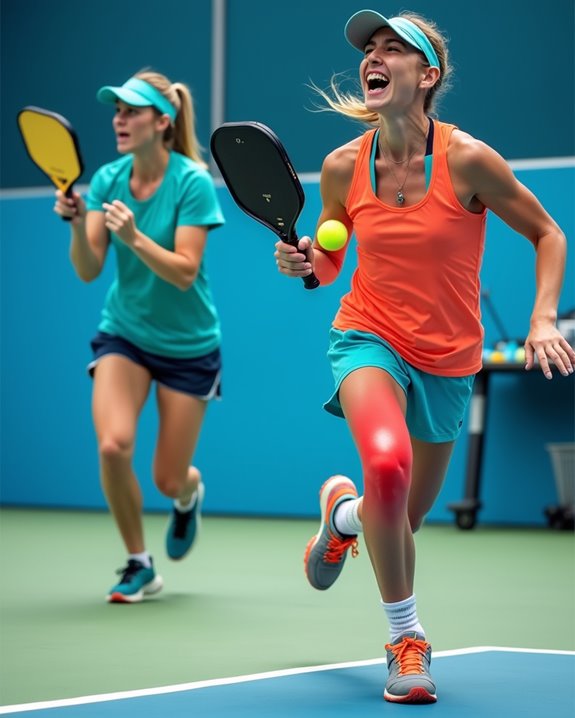When selecting the perfect pickleball glove, focus on premium materials like cabretta leather for grip, breathable mesh backing, and proper fit that feels like a second skin. You’ll want a glove that enhances paddle control while preventing those game-interrupting blisters during intense rallies. Consider your budget carefully—from $20 starter options to $45 gourmet selections with buttery-smooth feel. The right glove transforms your game from bland to brilliant, serving up confidence with every swing.
Key Takeaways
- Choose premium cabretta leather for superior grip, while mesh backing ensures breathability during intense matches.
- Properly fitted gloves enhance paddle control, prevent blisters, and reduce hand fatigue during extended play.
- Consider material options carefully—leather offers exceptional feel but synthetics provide better moisture management in humid conditions.
- Follow manufacturer sizing guides and seek adjustable wrist straps for a customized fit that feels like a second skin.
- Balance your budget wisely: premium gloves ($25-45) offer superior durability and performance compared to budget options ($18-20).
The Complete Guide to Selecting the Best Pickleball Glove for Your Game
When you’re slicing through the air for that perfect dink shot, you’ll want a glove that feels like an extension of your hand rather than a barrier. Selecting the right pickleball gloves comes down to a handful of key ingredients.
First, examine the palm material—premium cabretta leather delivers that five-star grip you crave, helping you serve up powerful shots with confidence. The breathability factor is equally essential; look for gloves with mesh backing that allows your hands to “breathe” while you’re heating up the kitchen line.
Moisture control can make or break your game. Quality gloves wick away sweat like a paper towel absorbing spills. Finally, don’t underestimate proper fit—too tight, and you’ll feel restricted; too loose, and you’ll lose precision during those significant volleys.
Why Pickleball Gloves Are Essential for Every Player
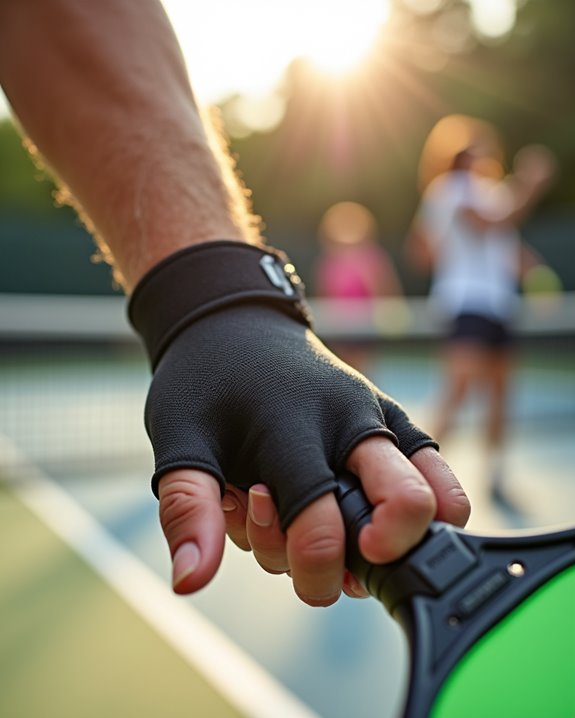
Five essential reasons make pickleball gloves a must-have accessory rather than just an optional garnish to your equipment lineup. Pickleball gloves offer remarkable benefits that transform your performance on the court, similar to how salt enhances a perfectly prepared dish.
First, they enhance grip on your paddle, preventing it from slipping away during those sizzling exchanges at the kitchen line. When sweaty palms threaten your control, gloves guarantee you maintain a firm hold. They also protect your hands from blisters that can leave you feeling raw after intensive rallies.
You’ll notice reduced hand fatigue during longer matches, allowing you to maintain precision through every serve and volley. The cumulative effect notably improves your overall gameplay, letting you focus on strategy rather than discomfort.
Top Pickleball Glove Materials: Leather vs. Synthetic Options

Now that you’ve seen why gloves deserve a place in your pickleball pantry, let’s examine the main ingredients that make up these hand-saving accessories.
Leather gloves serve as the prime cut of hand protection, offering pickleball players a buttery-smooth feel that marinates to your hand’s unique shape over time. They deliver exceptional grip on the paddle but come with a premium price tag ($20-$45).
Premium leather gloves mold to your hand like a custom-fitted kitchen mitt—comfort that costs a bit more but pays dividends in paddle control.
In contrast, synthetic gloves are the quick-prep alternative—more affordable starting at $13, with excellent moisture-wicking properties that keep your hands fresh during intense gameplay. While they won’t mold to your hand like leather, they maintain consistent comfort and playability right out of the package.
Consider your playing conditions carefully—leather absorbs moisture like a sponge, while synthetics offer better breathability in humid kitchen battles.
Finding Your Perfect Fit: Sizing and Adjustment Features
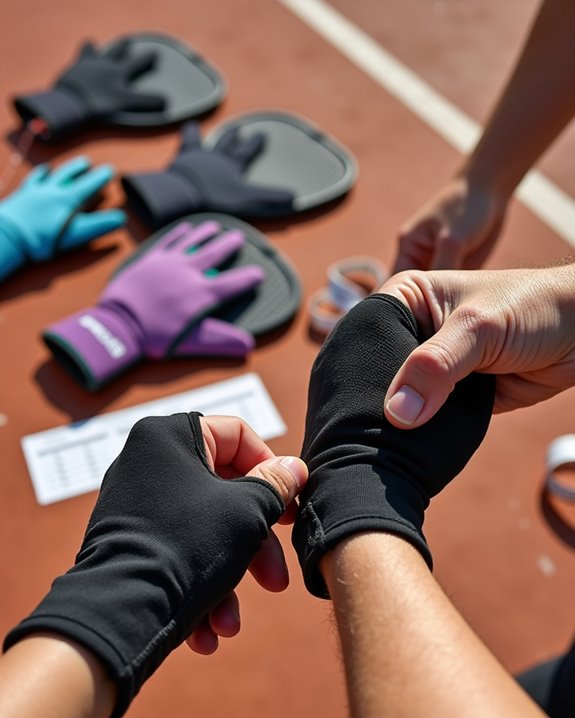
Why would you spend hours perfecting your pickleball serve only to sabotage your game with an ill-fitting glove? Just like selecting the perfect knife for precise dicing, proper glove sizing creates the foundation for ideal performance on the court.
Most brands now offer detailed sizing guides that help you measure for a glove that fits like it was custom-made for your hand. When trying options, test for comfort and flexibility by mimicking a paddle grip—your glove should feel like a second skin, not a bulky oven mitt!
Don’t overlook adjustable wrist straps, which let you fine-tune support like seasoning a perfect dish. Remember that brand-specific size charts are essential, as dimensions vary between manufacturers. The perfect fit guarantees your hands stay fresh through marathon matches.
Grip Enhancement: How the Right Glove Improves Control
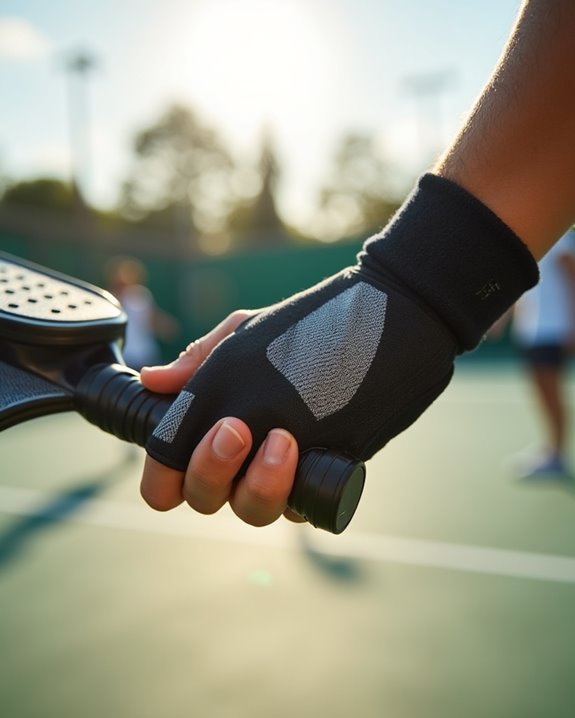
With the perfect fit secured, let’s grip the heart of performance enhancement. Pickleball gloves crafted from perforated cabretta leather serve up an enhanced grip that’s as satisfying as perfectly seared scallops—crisp on contact, yet delicately responsive. You’ll immediately notice the tactile difference in your paddle control.
When you’re heating up on the court, moisture-wicking materials keep your hands dry, maintaining that firm grip even when the action sizzles. It’s like having a non-stick surface for your most important kitchen tool—your hand!
Ergonomically designed gloves reduce hand fatigue while you fold in those strategic dinks and powerful drives. The snug fit and adjustable wrist straps provide the stability you need to plate those precision shots consistently, serving up confidence with every swing.
Breathability and Moisture Management Features Worth Considering
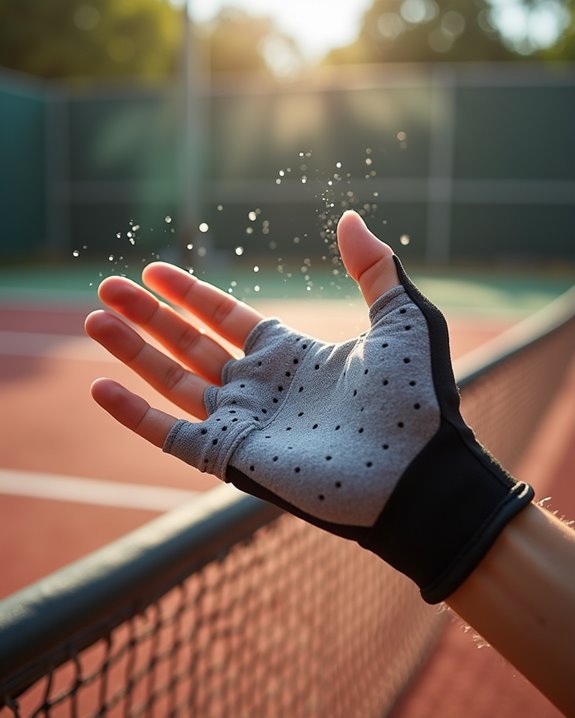
Perspiration poses the ultimate pickleball performance challenge—like oil splattering in a hot pan, it disrupts your perfect grip. When selecting gloves, prioritize breathability through mesh-backed designs that create constant airflow to your skin, keeping hands cool during heated rallies.
You’ll want moisture-wicking synthetic materials that pull sweat away from your palm like a paper towel absorbing spills. Look for gloves featuring fingerless designs—they’re the secret ingredient for maximum ventilation while maintaining control during those critical kitchen-line exchanges.
The perfect glove combines lightweight construction with strategically placed absorbent elements, similar to how a chef balances flavors. Integrated sweatbands or terry cloth sections can be game-changers, especially in humid conditions when you’re serving up your best shots.
Durability Factors That Determine Long-Term Value

Investing in pickleball gloves that’ll stand the test of time resembles choosing a well-seasoned cast iron skillet—durability becomes the foundation of true value. You’ll want to simmer down your options by examining the quality of materials first, with cabretta leather offering the perfect blend of longevity and buttery-soft comfort.
When shopping, fold the glove like you’re kneading dough and inspect the reinforced stitching along pressure points. These reinforcements are the secret ingredients that prevent premature wear during intense volleys and smashes.
Don’t skip proper maintenance—it’s the garnish that completes the dish! Clean your gloves regularly and store them properly to maintain their performance. With high-quality materials and consistent care, your pickleball gloves will serve up reliable performance season after season.
Men’s vs. Women’s Pickleball Gloves: Key Differences
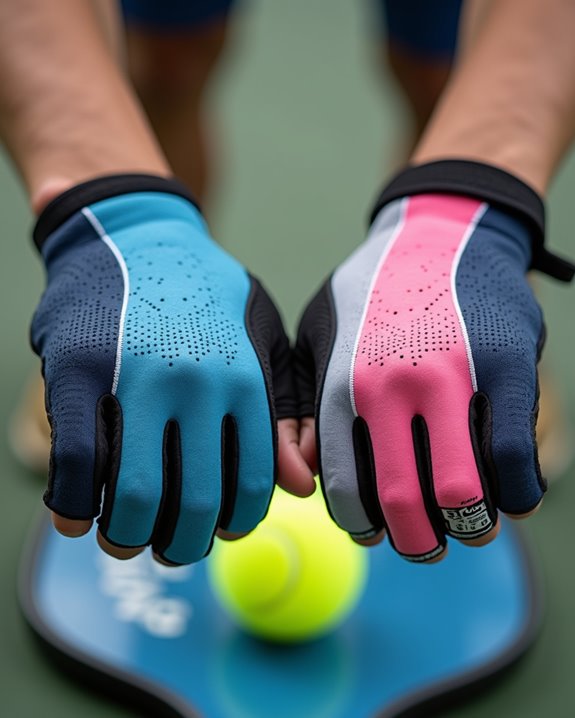
Just as the right ingredients make all the difference in a gourmet meal, men’s and women’s pickleball gloves aren’t simply carbon copies with different color schemes. When selecting your perfect match, consider the recipe for ideal performance.
Men’s pickleball gloves are crafted with larger hand dimensions and wider finger widths—like a heartier portion on the plate. They often feature robust padding to complement a powerful grip and typically come in more subdued color palettes.
In contrast, women’s pickleball gloves are designed with a more delicate touch—offering enhanced flexibility for quick, precise movements. You’ll find narrower fits, vibrant designs, and lighter materials that won’t weigh you down during intense rallies.
Don’t skip consulting sizing charts before making your selection—they’re your recipe for glove-fitting success!
Price Range Analysis: Budget-Friendly to Premium Options

Every pickleball enthusiast faces the financial menu of glove options, with prices simmering from a modest $13 to a sizzling $45. When shopping, you’re fundamentally choosing between different cuts of quality, with each price point offering distinct flavor profiles for your game.
Budget-friendly options around $20, like Franklin Sports gloves, provide a satisfying appetizer for casual players. For the main course, consider mid-range options from Bionic or Wilson ($18-$25) that blend affordability with respectable performance.
For the gourmet experience, premium options like the Cuzina HexPro ($45) serve up cabretta leather that feels buttery-smooth while delivering exceptional durability. Remember, material quality often determines how long your investment will stay fresh on the court. The best value isn’t always the cheapest—sometimes paying more upfront creates a more satisfying gameplay recipe long-term.
Frequently Asked Questions
Are Pickleball Gloves Worth It?
Like a guardian angel for your paddle, pickleball gloves are worth it. They’re made with various materials for grip enhancement, injury prevention, and temperature control, catering to your player preferences unlike traditional pickling techniques.
What Game Has Similar Skills to the Game of Pickleball?
You’ll find tennis skills, badminton techniques, racquetball strategies, table tennis, squash fundamentals, and other paddle sports all share similarities with pickleball. These games develop the same hand-eye coordination, footwork, and shot placement abilities you’ll need.
Is It Legal to Wear a Glove in Pickleball?
You might worry about rules, but yes, it’s completely legal to wear gloves in pickleball. They offer grip enhancement benefits, hand protection, and performance improvement factors while addressing weather impact consideration and personal comfort preferences through various material choices.

